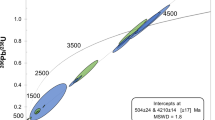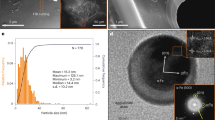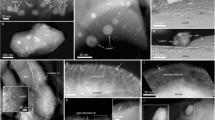Abstract
Micrometeorite impacts are one of the main drivers of lunar space weathering and can alter the properties of lunar regolith. However, the details of such processes are not well understood yet. We used transmission electron microscopy to study a micrometeorite impact crater on a glass bead returned by Chang’e-5. We detected Ti-oxide deposits on the crater rim and identified their detailed structure as rutile (TiO2), trigonal Ti2O and triclinic Ti2O. The trigonal Ti2O and triclinic Ti2O are newly discovered mineral phases in lunar samples. We show that these Ti-oxide deposits could have formed by vaporization or deposition processes following a high-velocity microimpact on the lunar regolith. We suggest that such Ti minerals are previously overlooked space-weathering products on the Moon. Similar alterations to photocatalytic properties and reflectance spectra of regolith may also happen on other airless planetary bodies in the Solar System.
This is a preview of subscription content, access via your institution
Access options
Access Nature and 54 other Nature Portfolio journals
Get Nature+, our best-value online-access subscription
$29.99 / 30 days
cancel any time
Subscribe to this journal
Receive 12 digital issues and online access to articles
$119.00 per year
only $9.92 per issue
Buy this article
- Purchase on Springer Link
- Instant access to full article PDF
Prices may be subject to local taxes which are calculated during checkout




Similar content being viewed by others
Data availability
All data in the paper are presented in the paper or the Supplementary Information. The unprocessed SEM and TEM data for Figs. 1–3 are available to download from figshare at https://doi.org/10.6084/m9.figshare.25244650.
Code availability
No code is used in this study.
References
Noguchi, T. et al. Incipient space weathering observed on the surface of Itokawa dust particles. Science 333, 1121–1125 (2011).
Pieters, C. M. et al. Distinctive space weathering on Vesta from regolith mixing processes. Nature 491, 79–82 (2012).
Pieters, C. M. & Noble, S. K. Space weathering on airless bodies. J. Geophys. Res. Planets 121, 1865–1884 (2016).
Matsumoto, T., Harries, D., Langenhorst, F., Miyake, A. & Noguchi, T. Iron whiskers on asteroid Itokawa indicate sulfide destruction by space weathering. Nat. Commun. 11, 1–8 (2020).
Hapke, B. Space weathering from Mercury to the asteroid belt. J. Geophys. Res. Planets 106, 10039–10073 (2001).
Bennett, C. J., Pirim, C. & Orlando, T. M. Space-weathering of Solar System bodies: a laboratory perspective. Chem. Rev. 113, 9086–9150 (2013).
Keller, L. P. & McKay, D. S. Discovery of vapor deposits in the lunar regolith. Science 261, 1305–1307 (1993).
Cintala, M. J. Impact‐induced thermal effects in the lunar and Mercurian regoliths. J. Geophys. Res. Planets 97, 947–973 (1992).
Cremonese, G., Borin, P., Lucchetti, A., Marzari, F. & Bruno, M. Micrometeoroids flux on the Moon. Astron. Astrophys. 551, A27 (2013).
Burgess, K. D. & Stroud, R. M. Phase-dependent space weathering effects and spectroscopic identification of retained helium in a lunar soil grain. Geochim. Cosmochim. Acta 224, 64–79 (2018).
Gu, L. et al. Space weathering of the Chang’e‐5 lunar sample from a mid‐high latitude region on the Moon. Geophys. Res. Lett. 49, e2022GL097875 (2022).
Li, Y. et al. Crystal orientation results in different amorphization of olivine during solar wind implantation. J. Geophys. Res. Planets 118, 1974–1982 (2013).
Zeng, X. et al. Experimental investigation of OH/H2O in H+-irradiated plagioclase: implications for the thermal stability of water on the lunar surface. Earth Planet. Sci. Lett. 560, 116806 (2021).
Sasaki, S., Nakamura, K., Hamabe, Y., Kurahashi, E. & Hiroi, T. Production of iron nanoparticles by laser irradiation in a simulation of lunar-like space weathering. Nature 410, 555–557 (2001).
Wu, Y., Li, X., Yao, W. & Wang, S. Impact characteristics of different rocks in a pulsed laser irradiation experiment: simulation of micrometeorite bombardment on the Moon. J. Geophys. Res. Planets 122, 1956–1967 (2017).
Keller, L. P. & McKay, D. S. The nature and origin of rims on lunar soil grains. Geochim. Cosmochim. Acta 61, 2331–2341 (1997).
Noble, S. K., Pieters, C. M. & Keller, L. P. An experimental approach to understanding the optical effects of space weathering. Icarus 192, 629–642 (2007).
Anand, M. et al. Space weathering on airless planetary bodies: clues from the lunar mineral hapkeite. Proc. Natl Acad. Sci. USA 101, 6847–6851 (2004).
Gu, L. et al. The discovery of silicon oxide nanoparticles in space-weathered of Apollo 15 lunar soil grains. Icarus 303, 47–52 (2018).
Christoffersen, R., McKay, D. S. & Keller, P. Microstructure, chemistry, and origin of grain rims on ilmenite from the lunar soil finest fraction. Meteorit. Planet. Sci. 31, 835–848 (1996).
Zhang, S. & Keller, L. P. A STEM-EELS study of the effect of solar-wind irradiation on the ilmenite from lunar soil. Microsc. Microanal. 16, 1216–1217 (2010).
Papike, J. J., Ryder, G. & Shearer, C. K. in Planetary Materials (ed. Papike, J. J.) Ch. 5 (Mineralogical Society of America, 1998).
Li, C. et al. Characteristics of the lunar samples returned by the Chang’e-5 mission. Natl Sci. Rev. 9, nwab188 (2022).
Che, X. et al. Age and composition of young basalts on the Moon, measured from samples returned by Chang’e-5. Science 374, 887–890 (2021).
Li, Q. L. et al. Two-billion-year-old volcanism on the Moon from Chang’e-5 basalts. Nature 600, 54–58 (2021).
Delano, J. W. Pristine lunar glasses: criteria, data, and implications. J. Geophys. Res. 91, 201–213 (1986).
Naney, M. T., Crowl, D. M. & Papike, J. J. The Apollo 16 drill core: statistical analysis of glass chemistry and the characterization of a high alumina-silica poor (HASP) glass. In Lunar and Planetary Science Conference Proc. 155–184 (Pergamon, 1976).
Lucey, P. et al. Understanding the lunar surface and space–Moon interactions. Rev. Mineral. Geochem. 60, 83–219 (2006).
Rubin, A. E. & Ma, C. Meteoritic minerals and their origins. Geochemistry 77, 325–385 (2017).
Fan, Y. et al. Structure and transport properties of titanium oxide (Ti2O, TiO1 + δ, and Ti3O5) thin films. J. Alloys Compd. 786, 607–613 (2019).
Miyahara, M. et al. Discovery of seifertite in a shocked lunar meteorite. Nat. Commun. 4, 1737 (2013).
Kayama, M. et al. Discovery of moganite in a lunar meteorite as a trace of H2O ice in the Moon’s regolith. Sci. Adv. 4, eaar4378 (2018).
Zhang, A. C., Pang, R. L., Sakamoto, N. & Yurimoto, H. The Cr-Zr-Ca armalcolite in lunar rocks is loveringite: constraints from electron backscatter diffraction measurements. Am. Mineral. 105, 1021–1029 (2020).
Christoffersen, R., Keller, L. P., Dukes, C., Rahman, Z. & Baragiola, R. Experimental investigation of space radiation processing in lunar soil ilmenite: combining perspectives from surface science and transmission electron microscopy. In Lunar and Planetary Science Conference 1532 (NASA, 2010).
Greer, J. et al. Atom probe tomography of space‐weathered lunar ilmenite grain surfaces. Meteorit. Planet. Sci. 55, 426–440 (2020).
Gordienko, A. & Kaye, A. B. Unique pulsed-laser deposition production of anatase and rutile TiO2 on Al2O3. Cryst. Struct. Theory Appl. 7, 19–31 (2018).
Fathi-Hafshejani, P. et al. Laser-assisted selective and localized surface transformation of titanium to anatase, rutile, and mixed phase nanostructures. J. Laser Appl. 33, 012014 (2021).
Bilson, E., Gold, T. & Gull, G. The simulation of lunar micrometeorite impacts by laser pulses. Moon 6, 405–413 (1973).
Hapke, B. Darkening of silicate rock powders by solar wind sputtering. Earth Moon Planets 7, 342–355 (1973).
Lucey, G., Blewett, D. T. & Hawke, B. R. Mapping the FeO and TiO2 content of the lunar surface with multispectral imagery. J. Geophys. Res. Planets 103, 3679–3699 (1998).
Robertson, R. et al. Textural and compositional effects of ilmenite on the spectra of high-titanium lunar basalts. Icarus 375, 114836 (2022).
Li, X., Wu, J., Wen, M., Tang, X. & Liu, Y. Particular properties of Ti2O and TiNx nanoparticles prepared by thermal decomposition. Rare Met. 27, 598–602 (2008).
Nakata, K. & Fujishima, A. TiO2 photocatalysis: design and applications. J. Photochem. Photobiol. C, Photochem. Rev. 13, 169–189 (2012).
Fujishima, A., Zhang, X. & Tryk, D. A. TiO2 photocatalysis and related surface phenomena. Surf. Sci. Rep. 63, 515–582 (2008).
Tang, X. et al. Application of natural minerals in photocatalytic degradation of organic pollutants: a review. Sci. Total Environ. 812, 152434 (2022).
Yao, Y. et al. Extraterrestrial photosynthesis by Chang’e-5 lunar soil. Joule 6, 1008–1014 (2022).
Aponte, J. C. et al. Extraterrestrial organic compounds and cyanide in the CM2 carbonaceous chondrites Aguas Zarcas and Murchison. Meteorit. Planet. Sci. 55, 1509–1524 (2020).
Parker, E. et al. Amino acid analyses of a sample of Ryugu by a combination of liquid chromatography and high-resolution mass spectrometry techniques. LPI Contrib. 2678, 2651 (2022).
Acknowledgements
We were allocated the Chang’e-5 sample by the China National Space Administration. We thank A. Zhang and T. Long for their suggestions about this work. We are grateful to L. Maltagliati for the editorial handling of the manuscript. X. Zeng is supported by the National Key Research and Development Programme of China (Grant No. 2022YFF0503100), the B-type Strategic Priority Programme of the Chinese Academy of Sciences (Grant No. XDB41000000) and the National Natural Science Foundation of China (Grant No. 42103036). X.L. is supported by the National Natural Science Foundation of China (Grant No. 41931077), the Strategic Priority Programme of the Chinese Academy of Sciences (Grant No. XDB41020300) and Guizhou Provincial Science and Technology Projects (Grant No. GZ2019SIG). X. Zhang is supported by the Science and Technology Development Fund of Macau (Grant No. 0014/2022/A1). J.L. acknowledges support from the National Key Research and Development Programme of China (Grant No. 2022YFF0503100) and the B-type Strategic Priority Programme of the Chinese Academy of Sciences (Grant No. XDB41000000). W.Y. is supported by the National Natural Science Foundation of China (Grant No. 42241104). Y. Wu acknowledges support from the National Natural Science Foundation of China (Nos. 42203047 and 42241108), Science and Technology Planning Project of Guangzhou (Grant Nos. 2024A04J9999 and 202102021184) and the Innovation Training Programme for College Students of Guangdong Province (Grant No. S202111845208).
Author information
Authors and Affiliations
Contributions
X. Zeng prepared the Chang’e-5 sample, recognized the Ti-oxide deposits on the rim of micrometeorite impact crater, performed the research and prepared the initial paper. X. Zhang contributed to the discussion of new Ti minerals on the Moon. X. Zhang, X.L. and J.L. designed the research. W.Y., B.M. and Y. Wen provided technical support. Y. Wu and X. Zhao performed the TEM analysis. All authors participated in the discussion of the results, data interpretation and paper editing.
Corresponding authors
Ethics declarations
Competing interests
The authors declare no competing interests.
Peer review
Peer review information
Nature Astronomy thanks Katherine Burgess, Lingzhi Sun and the other, anonymous, reviewer(s) for their contribution to the peer review of this work.
Additional information
Publisher’s note Springer Nature remains neutral with regard to jurisdictional claims in published maps and institutional affiliations.
Supplementary information
Supplementary Information
Supplementary Figs. 1–14 and Table 1.
Rights and permissions
Springer Nature or its licensor (e.g. a society or other partner) holds exclusive rights to this article under a publishing agreement with the author(s) or other rightsholder(s); author self-archiving of the accepted manuscript version of this article is solely governed by the terms of such publishing agreement and applicable law.
About this article
Cite this article
Zeng, X., Wu, Y., Yu, W. et al. Unusual Ti minerals on the Moon produced by space weathering. Nat Astron (2024). https://doi.org/10.1038/s41550-024-02229-4
Received:
Accepted:
Published:
DOI: https://doi.org/10.1038/s41550-024-02229-4



